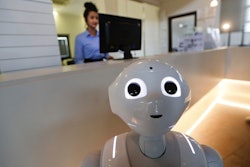Factories have changed considerably over the last century. One of the most significant changes to occur during this time has been the introduction of robots to the manufacturing process.
With all of this automation, it is easy to believe that these modern factories are futuristic environments where machines outperform human workers at every turn. However, most of these machines are not as smart as they may seem.
Industrial robots may be better at performing precision tasks, but they are designed and programmed to operate in a very narrow range. They can do what they were programmed to do, but they can’t make complex decisions and they can even be a dangerous work companion to humans.
This is where developments in artificial intelligence (AI) are going to change the face of automation in manufacturing. By utilizing similar innovation foundations that began with custom mobile app development for AI applications, factories will soon be able to integrate technology to improve their overall manufacturing process.
As the technology matures, AI systems are going to gain better decision-making capabilities which will increase the potential for AI and automation to spread to other parts of the manufacturing process.
Improving Safety
When General Motors introduced the first Unimate robotic arms to assembly lines back in the 1960s, it was a move intended to improve workplace safety. These machines were not particularly smart, but they could take over the dangerous work of welding and moving die-castings.
Move forward to the modern day, and it is artificial intelligence that’s going to be used to make a safer workplace. Humans and robots have been sharing a work environment for many decades. However, there is still the possibility that a robotic worker could accidentally cause harm to a human worker that shares its environment.
The rule-based nature of most autonomous systems is part of the problem. Working with humans can be unpredictable, and unpredictable behaviors and actions are hard to account for in rule-based programming. Machine learning, however, provides an answer to this problem.
With machine learning, an AI system can analyze volumes of data to discern meaningful patterns. This allows the system to learn and improve without having to be programmed for a specific task. Coupled with sensors, a device that uses machine learning could be more aware of the environment around it and make decisions based on the feedback from the sensors. The robot would then be able to recognize a dangerous situation, and take steps to prevent harm to any humans that may be nearby.
AI Moving to New Markets
Manufacturing is a high-cost endeavor for most businesses. It requires considerable capital investments and the profit margin can be small in comparison. In the past, this pushed many companies to move manufacturing to countries where labor costs were low.
In environments where labor costs are low, there is less of an incentive to make large investments in automation and artificial intelligence. If low-cost workers can do the job, there is little to be saved by investing in these technologies.
However, global standards of living and wages are on the rise. As the cost of labor increases in these markets, the incentive to automate will increase along with it. As is already happening in many countries, workers are going to lose jobs to automation and AI.
As wages continue to increase and the cost of automation decreases, manufacturers in countries like China and India are going to make a stronger push towards automation in factories. As people lose factory jobs in these countries, they will experience issues that have been the longtime concern of workers in the US: the need to adapt to the loss of work and retrain for a new career.
Beyond the Factory Floor
The physical manufacturing process is one of the more obvious ways that artificial intelligence is going to change industry. AI will be used to create robots that have greater capabilities and it is going to make these robots better co-workers to their human counterparts. But the changes are not limited to the factory floor.
Artificial intelligence is also set to impact the supply chain. Smart algorithms will be able to analyze vast amounts of data to forecast market demand.
By analyzing information concerning things like consumer demand over time, social and political developments, weather, market behavior, and more, an AI system would be able to recognize patterns that could be used to manage production. The output could then be used to help companies make better decisions about things like staffing, financial investment, resource management, and inventory, among others.
Predictive maintenance is another area where AI can help to improve manufacturing. Instead of servicing equipment based on a maintenance schedule, machines could be equipped with sensors that monitor performance and operating conditions. Hypothetically, this data is then used to predict maintenance issues before they occur.
The maintenance department could take preemptive action to prevent the breakdown of equipment, which would lead to less down time for repairs and maintenance. This has the potential to save the company money by avoiding damage that would result in the need for expensive replacement parts.
In the short term, artificial intelligence is going to cost some human workers their jobs. But in the long run, goals are set to place humans next to these newly developed machines. The challenge will be to train human workers for this future of engaging with or servicing the robots that are going to play an ever increasing role in modern manufacturing.
Rae Steinbach is a Freelance Editor at Y Media Labs.























